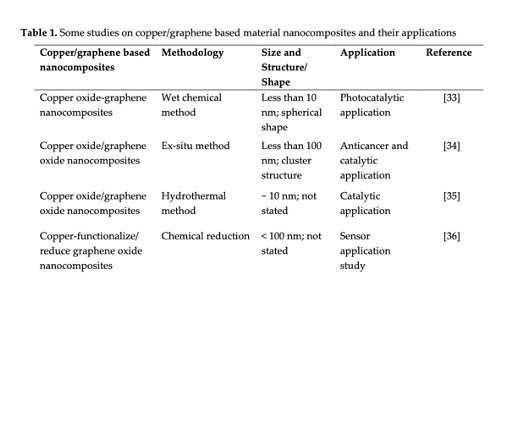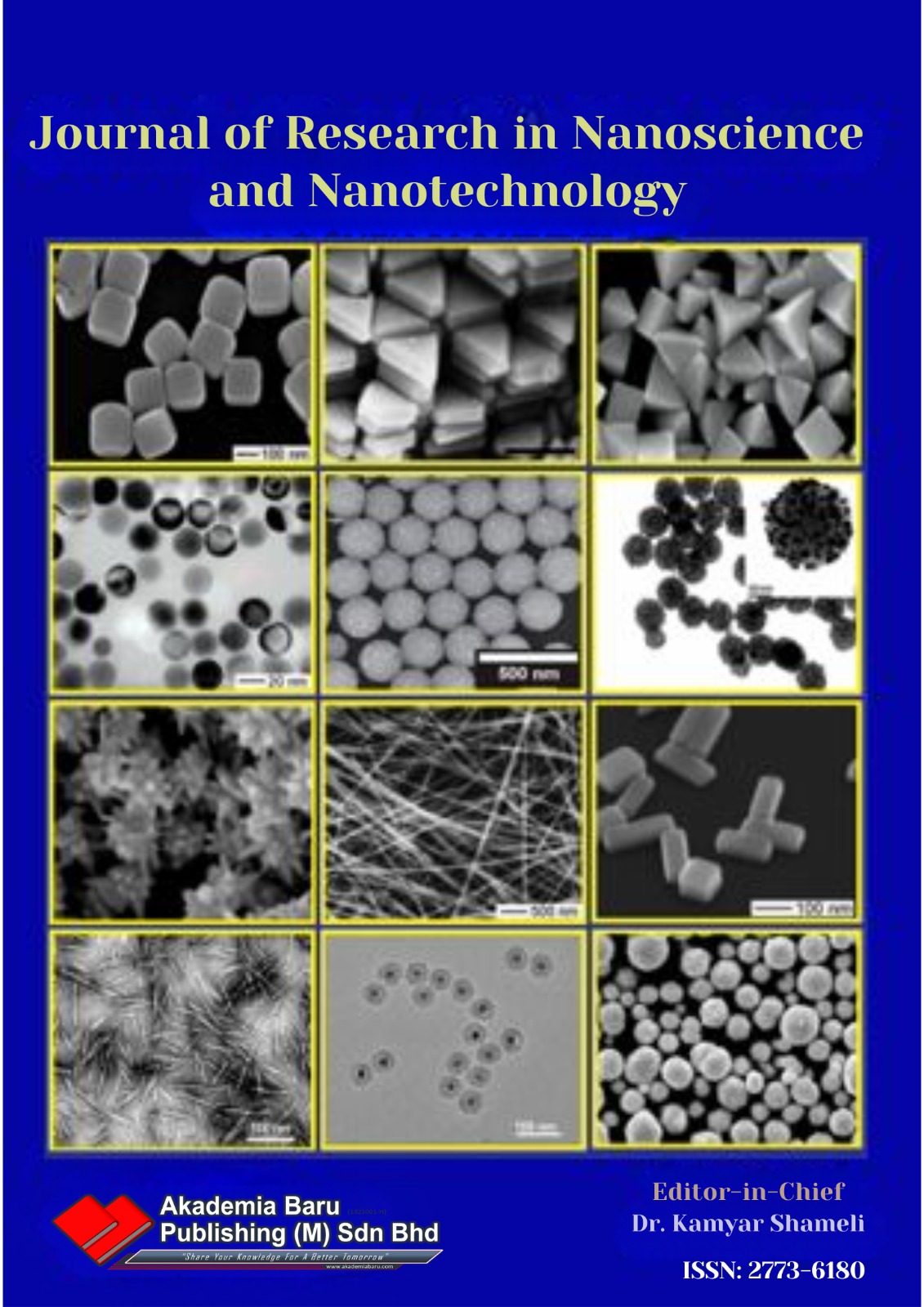Copper/Graphene Based Materials Nanocomposites and their Antibacterial Study: A Mini Review
DOI:
https://doi.org/10.37934/jrnn.1.1.4452Keywords:
Copper nanoparticles, graphene based materials, nanocomposites, antibacterialAbstract
Due to their biocidal activity properties, graphene based materials have been widely studied especially in biomedical, agriculture and water treatment process which focus on mitigating the microbial resistance problem. However, the antibacterial performance of these materials alone are relatively weak and need to be improved in order to enhance their biological activity. Copper nanoparticles is a low cost metal also has the antibacterial properties which is almost similar with the silver and gold nanoparticles. The combination of these two materials had produced to a new potential material as another alternative for the antibacterial agents. Therefore, in this work, a brief review of copper/graphene based material nanocomposites and their antibacterial study was discussed.
Downloads
References
Kumar, S.; Ojha, A.K.; Bhorolua, D.; Das, J.; Kumar, A.; Hazarika, A. Facile synthesis of CuO nanowires and Cu2O nanospheres grown on rGO surface and exploiting its photocatalytic, antibacterial and supercapacitive properties. Physica B Condens. Matter, 2019, 558, 74-81, doi: 10.1016/j.physb.2019.01.040.
Mohamad Sukri, S.N.A.; Shameli, K.; Mei-Theng Wong, M.; Teow, S-Y.; Chew, J.; Ismail, N.A. Cytotoxicity and antibacterial activities of plant-mediated synthesized zinc oxide (ZnO) nanoparticles using Punica granatum (pomegranate) fruit peels extract. J. Mol. Struct, 2019, 1189, 57-65, doi: 10.1016/j.molstruc.2019.04.026.
Bashir, F.; Irfan, M.; Ahmad, T.; Iqbal, J.; Butt, M.T.; Sadef, Y.; Umbreen, M.; Shaikh, I.A.; Moniruzzaman, M. Efficient utilization of low cost agro materials for incorporation of copper nanoparticles to scrutinize their antibacterial properties in drinking water. Environ. Technol. Innov., 2021, 21, 101228, doi: 10.1016/j.eti.2020.101228.
Iliger, K.S.; Sofi, T.A.; Bhat, N.A.; Ahanger, F.A.; Sekhar, J.C.; Elhendi, A.Z.; Al-Huqail, A.A.; Khan, F. Copper nanoparticles: Green synthesis and managing fruit rot disease of chilli caused by Colletotrichum capsici. Saudi J. Biol. Sci., 2021, 28(2), 1477-1486, doi: 10.1016/j.sjbs.2020.12.003.
Kumar, S.K.; Mamatha, G.; Muralidhara, H.; Anantha, M.; Yallappa, S.; Hungund, B.; Kumar, K.Y. Highly efficient multipurpose graphene oxide embedded with copper oxide nanohybrid for electrochemical sensors and biomedical applications. J. Sci. Adv. Mater and Devices, 2017, 2(4), 493-500, doi: 10.1016/j.jsamd.2017.08.003.
Yew, Y.P.; Shameli, K.; Miyake, M.; Ahmad Khairudin, N.B.; Mohamad, S.E.; Naiki, T.; Lee, K.X. Green biosynthesis of superparamagnetic magnetite Fe3O4 nanoparticles and biomedical applications in targeted anticancer drug delivery system: A review. Arab. J. Chem., 2020, 13(1), 2287-2308, doi: 10.1016/j.arabjc.2018.04.013.
Nasrollahzadeh, M.; Issaabadi, Z.; Sajadi, S.M. Green synthesis of a Cu/MgO nanocomposite by Cassytha filiformis L. extract and investigation of its catalytic activity in the reduction of methylene blue, congo red and nitro compounds in aqueous media. RSC Adv., 2018, 8(7), 3723-3735, doi: 10.1039/c7ra13491f.
Pande, S.A. Green Synthesis of Biopolymer-Silver Nanocomposites for Gas Sensing. Adv. Sci. Tech., 2016, 99, 54-60, doi: 10.4028/www.scientific.net/AST.99.54.
Bogdanovic, U.; Dimitrijevic, S.; Skapin, S.D.; Popovic, M. Rakocevic, Z.; Leskovac, A.; Petrovic, S.; Stoiljkovic, M.; Vodnik, V. Copper-polyaniline nanocomposite: Role of physicochemical properties on the antimicrobial activity and genotoxicity evaluation. Mater Sci Eng C Mater Biol Appl, 2018, 93, 49-60, doi: doi.org/10.1016/j.msec.2018.07.067.
Kumar, B.V.N.; Balla, P.K.; Chirauri, S.K.; Rao, T.K.V.; Ramakrishna, Y.; Rao, K.R. Synthesis and characterization of copper particles decorated reduced graphene oxide nano composites for the application of supercapacitors. International Conference on Renewable Energy Research and Education (RERE-2018), India, 8-10 February 2018; Rao, K.R.; Suneetha, R.J.; Krishna, D.; American Institute of Physics: Andhra Pradesh, India, 2018; 040008,1-7, doi: 10.1063/1.5047973.
Aazadfar, P.; Solati, E.; Dorranian, D. Properties of Au/Copper oxide nanocomposite prepared by green laser irradiation of the mixture of individual suspensions. Opt. Mater., 2018, 78, 388-395, doi: 10.1016/j.optmat.2018.02.050.
Fahiminia, M.; Shamabadi, N.S.; Nasrollahzadeh, M.; Sajadi, S.M. Phytosynthesis of Cu/rGO using Euphorbia cheiradenia Boiss extract and study of its ability in the reduction of organic dyes and 4-nitrophenol in aqueous medium. IET Nanobiotechnol, 2019, 13(2), 202-213, doi: 10.1049/iet-nbt.2018.5175.
Kim, K.; Chaudhari, K.N.; Kim, S.; Kim, Y.; Shin, K.S. Facile single-step synthesis of Cu-rGO nanocomposite through simultaneous reduction process and its peroxidase mimic activity. J. Ind Eng Chem, 2021, 95, 388-396, doi: 10.1016/j.jiec.2021.01.013.
Karim, M.R.; Hayami, S. Chemical, thermal, and light-driven reduction of graphene oxide: Approach to obtain graphene and its functional hybrids. In: Graphene Materials-Advanced Applications, Kyzas, G.Z.; Mitropoulos, A.C.; IntechOpen Limited: Londan, 2017; pp. 1-17, doi: 10.5772/67808.
Yusoff, N. Synthesis of functionalized graphene/copper oxide (cuo) nanocomposites and their catalytic activity. Master Degree, Universiti Malaya, Malaysia, 2013.
Khan, M.S.; Yadav, R.; Vyas, R.; Sharma, A.; Banerjee, M.K.; Sachdev, K. Synthesis and evaluation of reduced graphene oxide for supercapacitor application. Mater. Today: Proceedings, 2020, 30, 153-156, doi: 10.1016/j.matpr.2020.05.403.
Shahriary, L.; Athawale, A.A. Graphene oxide synthesized by using modified hummers approach. Int J Renew Energy Environ Eng, 2014, 2(01), 58-63.
De Silva, K.K.H.; Huang, H.H.; Joshi, R.K.; Yoshimura, M. Chemical reduction of graphene oxide using green reductants. Carbon, 2017, 119, 190-199, doi: 10.1016/j.carbon.2017.04.025.
Gan, L.; Li, B.; Chen, Y.; Yu, B.; Chen, Z. Green synthesis of reduced graphene oxide using bagasse and its application in dye removal: A waste-to-resource supply chain. Chemosphere, 2019, 219, 148-154, doi: 10.1016/j.chemosphere.2018.11.181.
Dos Santos, P.L.; Katic, V.; Toledo, K.C.F; Bonacin, J.A. Photochemical one-pot synthesis of reduced graphene oxide/Prussian blue nanocomposite for simultaneous electrochemical detection of ascorbic acid, dopamine, and uric acid. Sens. Actuators B Chem., 2018, 255, 2437-2447, doi: 10.1016/j.snb.2017.09.036.
Kang, X.; Teng, D.; Wu, S.; Tian, Z.; Liu, J.; Li, P.; Ma, Y.; Liang, C. Ultrafine copper nanoparticles anchored on reduced graphene oxide present excellent catalytic performance toward 4-nitrophenol reduction. J Colloid Interface Sci, 2020, 566, 265-270, doi: 10.1016/j.jcis.2020.01.097.
Yin, P.T.; Shah, S.; Chhowalla, M.; Lee, K-B. Design, synthesis, and characterization of graphene–nanoparticle hybrid materials for bioapplications. Chem. Rev., 2015, 115(7), 2483-2531, doi: 10.1021/cr500537t.
Jayabalan, T.; Matheswaran, M.; Preethi, V.; Naina Mohamed, S. Enhancing biohydrogen production from sugar industry wastewater using metal oxide/graphene nanocomposite catalysts in microbial electrolysis cell. Int. J. Hydrog. Energy, 2020, 45(13), 7647-7655, doi: 10.1016/j.ijhydene.2019.09.068.
Pang, Y.L.; Tee, S.F.; Lim, S.; Abdullah, A.Z.; Ong, H.C.; Wu, C-H.; Chong, W.C.; Mohammadu, A.W.; Mahmoudi, E. Enhancement of photocatalytic degradation of organic dyes using ZnO decorated on reduced graphene oxide (rGO). Desalination Water Treat, 2018, 108, 311-321, doi: 10.5004/dwt.2018.21947.
Guo, M.; Zhao, Y.; Zhang, F.; Xu, L.; Yang, H.; Song, X.; Bu, Y. Reduced graphene oxide-stabilized copper nanocrystals with enhanced catalytic activity and SERS properties. RSC Adv., 2016, 6(56), 50587-50594, doi: 10.1039/c6ra05186c.
Musa, A.A.M.; Hussein, M.Z.; Saiman, M.I.; Sani, H.A. Effect of gelatin-stabilized copper nanoparticles on catalytic reduction of methylene blue. Nanoscale Res. Lett., 2016, 438(11), 1-13, doi: 10.1186/s11671-016-1656-6.
Manoj, D.; Saravanan, R.; Santhanalakshmi, J.; Agarwal, S.; Gupta, V.K.; Boukherroub, R. Towards green synthesis of monodisperse Cu nanoparticles: An efficient and high sensitive electrochemical nitrite sensor. Sens. Actuators B Chem., 2018, 266, 873-882, doi: 10.1016/j.snb.2018.03.141.
Prasad, P.R.; Kanchi, S.; Naidoom E.B. In-vitro evaluation of copper nanoparticles cytotoxicity on prostate cancer cell lines and their antioxidant, sensing and catalytic activity: One-pot green approach. J Photochem Photobiol B, 2016, 161, 375-382, doi: 10.1016/j.jphotobiol.2016.06.008.
Varghese, B.; Kurian, M.; Krishna, S.; Athira, T.S. Biochemical synthesis of copper nanoparticles using Zingiber officinalis and Curcuma longa: Characterization and antibacterial activity study. Mater. Today: Proceedings, 2020, 25, 302-306, doi: 10.1016/j.matpr.2020.01.476.
Tu, Y.; Li, P.; Jiajia S.J.; Jiang, J.; Dai, F.; Yuanyan, W.G; Liang, C.; Guosheng, S.; Yanwen, T.; Haiping, F. Remarkable antibacterial activity of reduced graphene oxide functionalized by copper ions. In: Advance Functional Materials, Ritterbusch, J.; Vita, M.D.; Lenders, J.; Meskine, H. John Wiley & Sons, Inc.: Weinheim, 2021; pp. 1-16, doi: 10.1002/adfm.202008018.
Yang, Z.; Hao, X.; Chen, S.; Ma, Z.; Wang, W.; Wang, C.; Yue, L.; Sun, H.; Shao, Q.; Murugadoss, V.; Guo, Z. Long-term antibacterial stable reduced graphene oxide nanocomposites loaded with cuprous oxide nanoparticles. J Colloid Interface Sci, 2019, 533, 13-23, doi: 10.1016/j.jcis.2018.08.053.
Rios, P.L.; Povea, P.; Cerda-Cavieres, C.; Arroyo, J.L.; Morales-Verdejo, C.; Abarca, G.; Camarada, M.B. Novel in situ synthesis of copper nanoparticles supported on reduced graphene oxide and its application as a new catalyst for the decomposition of composite solid propellants. RSC Adv., 2019, 9(15), 8480-8489, doi: 10.1039/c9ra00789j.
Prashanti, B.; Damodharam, T. Fabrication of graphene–cuo nanocomposite with improved photocatalytic degradation for palladium solution under solar light irradiation. J. Nanosci. Technol., 2018, 4(5), 497-499, doi: 10.30799/jnst.149.18040509.
Ganesan, K.; Jothi, V.K.; Natarajan, A.; Rajaram, A.; Ravichandran, S.; Ramalingam, S. Green synthesis of copper oxide nanoparticles decorated with graphene oxide for anticancer activity and catalytic applications. Arab. J. Chem., 2020, 13(8), 6802-6814, doi: 10.1016/j.arabjc.2020.06.033.
Zhang, K.; Suh, J.M.; Lee, T.H.; Cha, J.H.; Choi, J.W.; Jang, H.W.; Varma, R.S.; Shokouhimehr, M. Copper oxide-graphene oxide nanocomposite: efficient catalyst for hydrogenation of nitroaromatics in water. Nano Converg, 2019, 6(1), 1-7, doi: 10.1186/s40580-019-0176-3.
Na, H.G.; Cho, H.Y.; Kwon, Y.J.; Kang, S.Y.; Lee, C.; Jung, T.K.; Lee, H-S.; Kim, H.W. Reduced graphene oxide functionalized with Cu nanoparticles: Fabrication, structure, and sensing properties. Thin Solid Films, 2015, 588, 11-18, doi: 10.1016/j.tsf.2015.03.078.
Pratik, A.; Biswal, S.K.; Haridoss, P. Impact of enhanced interfacial strength on physical, mechanical and tribological properties of copper/reduced graphene oxide composites: Microstructural investigation. Ceram, Int,, 2020, 46(14), 22539-22549, doi: 10.1016/j.ceramint.2020.06.014.
Moozarm Nia, P.; Woi, P.M.; Alias, Y. Facile one-step electrochemical deposition of copper nanoparticles and reduced graphene oxide as nonenzymatic hydrogen peroxide sensor. Appl. Surf. Sci., 2017, 413, 56-65, doi: 10.1016/j.apsusc.2017.04.043.
Xu, X.; Shen, J.; Qin, J.; Duan, H.; He, G.; Chen, H. Cytotoxicity of bacteriostatic reduced graphene oxide-based copper oxide nanocomposites. JOM, 2019, 71(1), 294-300, doi: 10.1007/s11837-018-3197-1.
Zhang, W.; Chang, Q.; Xu, L.; Li, G.; Yang, G.; Ding, X.; Wang, X.; Cui, D.; Jiang, X. Graphene oxide-copper nanocomposite-coated porous cap scaffold for vascularized bone regeneration via activation of Hif-1alpha. Adv. Healthc. Mater., 2016, 11(5), 1299-1309, doi: 10.1002/adhm.201500824.
Ghorbi, E.; Namavar, M.; Rashedi, V.; Farhadinejad, S.; Pilban Jahromi, S.; Zareian, M. Influence of nano-copper oxide concentration on bactericidal properties of silver–copper oxide nanocomposite. Colloids Surf., 2019, 580, 123732, doi: 10.1016/j.colsurfa.2019.123732.
Ismail, N.A.; Shameli, K.; Wong, M.M.; Teow, S-Y.; Chew, J.; Mohamad Sukri S.N.A. Antibacterial and cytotoxic effect of honey mediated copper nanoparticles synthesized using ultrasonic assistance. Mater Sci Eng C Mater Biol Appl, 2019, 104, 109899, doi: 10.1016/j.msec.2019.109899.
Lopez-Lima, D.; Mtz-Enriquez, A.I.; Carrión, G.; Basurto-Cereceda, S.; Pariona, N. The bifunctional role of copper nanoparticles in tomato: Effective treatment for Fusarium wilt and plant growth promoter. Sci. Hortic., 2021, 277, 109810, doi: 10.1016/j.scienta.2020.109810.
Raju, C.H.A.I.; Nooruddin, S.; Babu, K.S. Studies on leaf extract mediated synthesis of copper nanoparticles for the removal of bromo cresol green dye from synthetic waste waters. Int. J. Sci. Eng. Technol. Res., 2017, 6(10), 1404-1411.
Liu, W.; Tao, Z.; Wang, D.; Liu, Q.; Zhang, Y.; Zhang, Y.; Dong, A. Immobilization of Cu (II) via a graphene oxide-supported strategy for antibacterial reutilization with long-term efficacy. J Hazard Mater, 2020, 124601, doi: 10.1016/j.jhazmat.2020.124601.
Alimardani, V.; Abolmaali, S.S.; Borandeh, S. Antifungal and antibacterial properties of graphene based nanomaterials: A mini-review. J. Nanostruct, 2019, 9(3), 402-413, doi: 10.22052/JNS.2019.03.002.
Navya Rani, M.; Murthy, M.; Shyla Shree, N.; Ananda, S.; Yogesh, S.; Dinesh, R. Cuprous oxide anchored reduced graphene oxide ceramic nanocomposite using Tagetes erecta flower extract and evaluation of its antibacterial activity and cytotoxicity. Ceram. Int., 2019, 45(18), 25020-25026, doi: 10.1016/j.ceramint.2019.04.195.
Hegab, H.M.; ElMekawy, A.; Zou, L.; Mulcahy, D.; Saint, C.P.; Ginic-Markovic, M. The controversial antibacterial activity of graphene-based materials. Carbon, 2016, 105, 362-376, doi: 10.1016/j.carbon.2016.04.046.
Sanchez-Lopez, E.; Gomes, D.; Esteruelas, G.; Bonilla, L.; Lopez-Machado, A.L.; Galindo, R.; Cano, A.; Espina, M.; Ettcheto, M.; Camins, A.; Silva, A.M.; Durazzo, A.; Santini, A.; Garcia, M.L.; Sauto, E.B. Metal-based nanoparticles as antimicrobial agents: An overview. Nanomaterials (Basel), 2020, 10(2), 1-39, doi: 10.3390/nano10020292.
Alayandea, A.B.; Obaida, M.; Kima, I.S. Antimicrobial mechanism of reduced graphene oxide-copper oxide (rGOCuO) nanocomposite films: The case of Pseudomonas aeruginosa PAO1. Mater. Sci. Eng. C, 2020, 109, 110596, doi: 10.1016/j.msec.2019.110596.
Selim, M.S.; Samak, N.A.; Hao, Z.; Xing, J. Facile design of reduced graphene oxide decorated with Cu2O nanocube composite as antibiofilm active material. Mater. Chem. Phys., 2020, 239, 122300, doi: 10.1016/j.matchemphys.2019.122300.
Chen, M.; Li, Z.; Chen, L. Highly antibacterial rGO/Cu2O nanocomposite from a biomass precursor: Synthesis, performance, and mechanism. Nano Materials Sci., 2020, 2(2), 172-179, doi: 10.1016/j.nanoms.2019.09.005.
Zhu, J.; Wang, J.; Uliana, A.A.; Tian, M.; Zhang, Y.; Zhang, Y.; Volodin, A.; Simoens, K.; Yuan, S.; Li, J.; Lin, J.; Bernaerts, K.; Van der Bruggen, B. Mussel-inspired architecture of high-flux loose nanofiltration membrane functionalized with antibacterial reduced graphene oxide-copper nanocomposites. ACS Appl Mater Interfaces, 2017, 9(34), 28990-29001, doi: 10.1021/acsami.7b05930.
Menazea, A.A.; Ahmed, M.K. Synthesis and antibacterial activity of graphene oxide decorated by silver and copper oxide nanoparticles. J. Mol. Struct., 2020, 1218, 128536, doi: 10.1016/j.molstruc.2020.128536.
Rajapaksha, P.; Cheeseman, S.; Hombsch, S.; Murdoch, B.J.; Gangadoo, S.; Blanch, E.W.; Truong, Y.; Cozzolino, D.; McConville, C.F.; Crawford, R.J.; Truong, V.K.; Elbourne, A.; Chapman, J. Antibacterial properties of graphene oxide–copper oxide nanoparticle nanocomposites. ACS Appl Bio Mater, 2019, 2(12), 5687-5696, doi: 10.1021/acsabm.9b00754.
Li, Y.; Yang, D.; Cui, J. Graphene oxide loaded with copper oxide nanoparticles as an antibacterial agent against Pseudomonas syringae pv. tomato. RSC Adv., 2017, 7(62), 38853-38860, doi: 10.1039/c7ra05520j.















